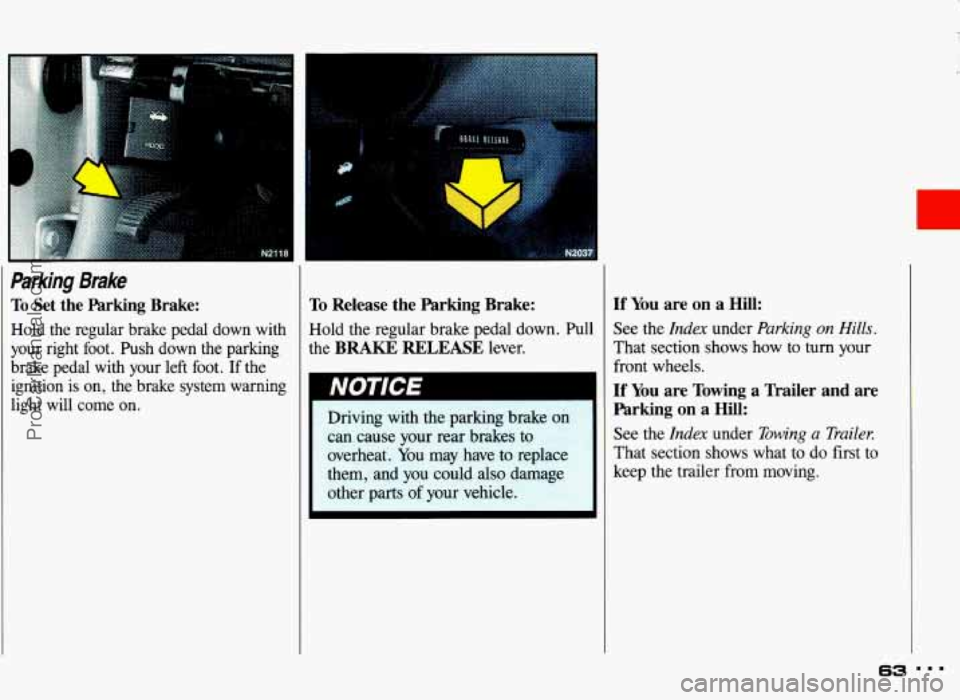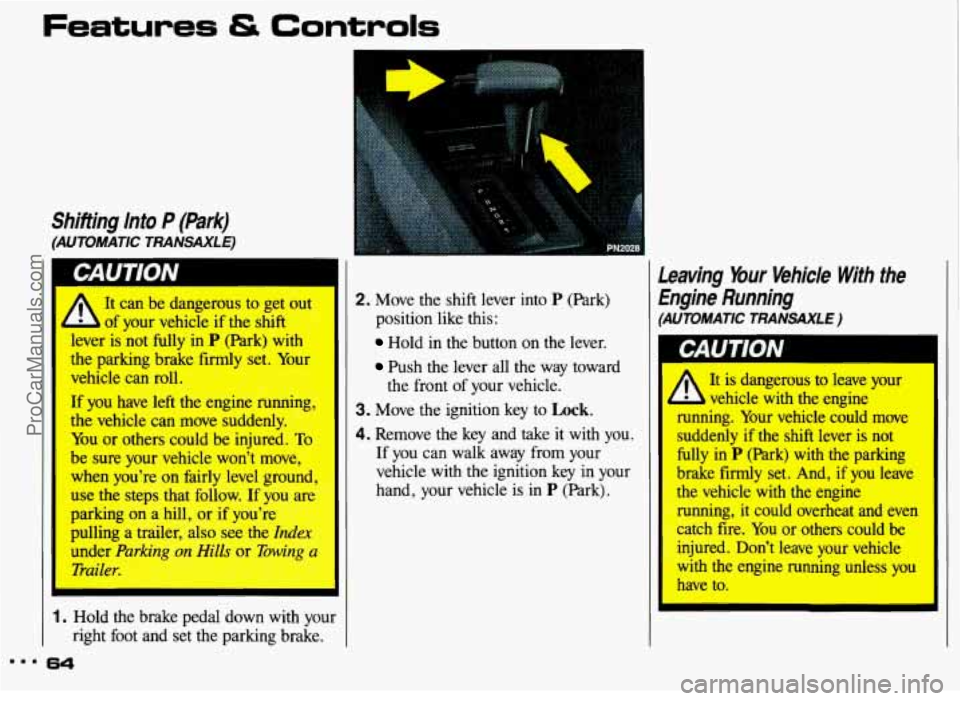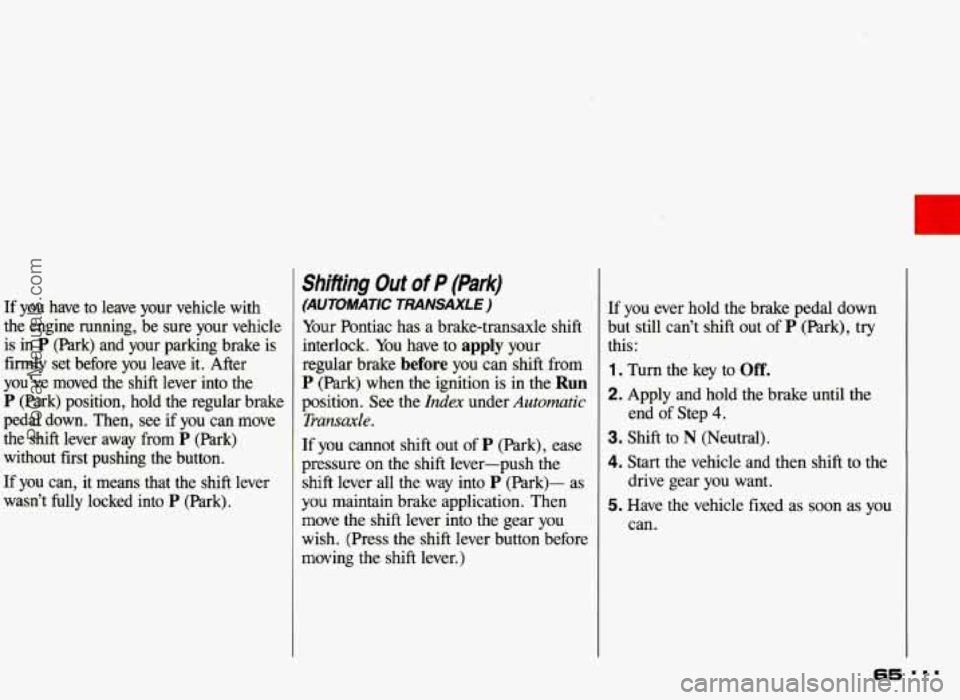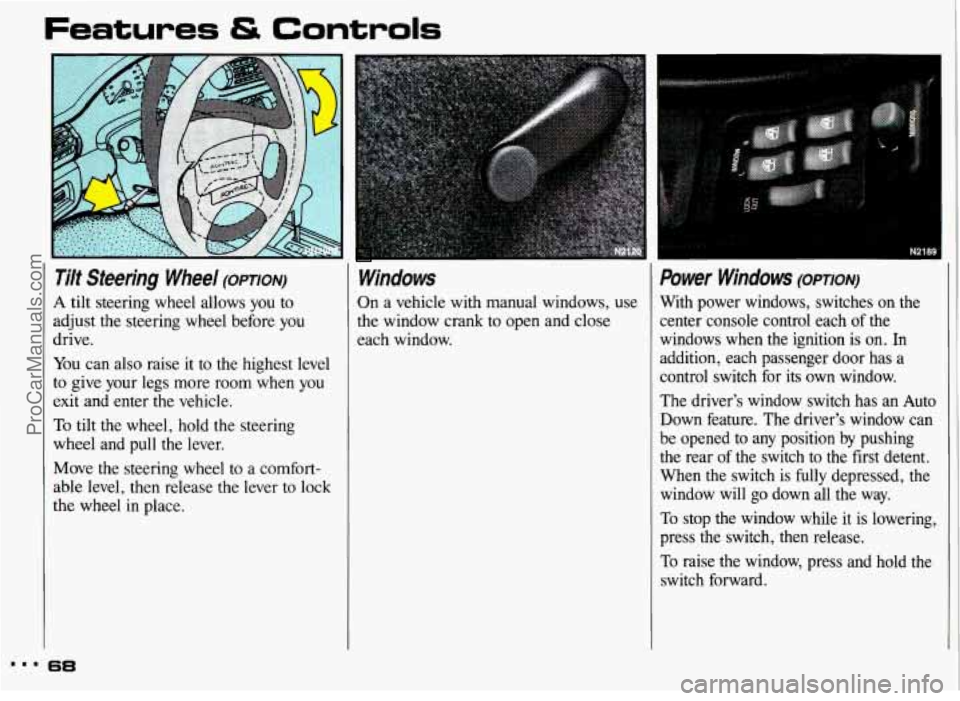1993 PONTIAC GRAND-AM ignition
[x] Cancel search: ignitionPage 56 of 306

NOTICE
Holding your key in Start for
longer than
15 seconds at a time
will cause your battery to be
drained much sooner. And the excessive heat can damage your starter motor.
4. If your engine still won’t start (or
starts but then stops), it could be
flooded
with too much gasoline. Try
pushing your accelerator pedal all thl
way to the floor and holding
it there
as you hold the key
in Start for abou
15 seconds. This clears the extra
gasoline from the engine.
Turn the
ignition key to
Off. Wait 10 seconds:
then repeat step
3.
1lL
Your engine is designed to work
with the electronics in your
vehicle.
If you add electrical parts
or accessories, you could change
the way the fuel injection system
operates. Before adding electrical
equipment, check with your dealer.
If you don’t, your engine might not
perform properly.
If you ever have to have your
vehicle towed, see the part of this
manual that tells how to do it
without damaging your vehicle.
See the
Index under Towing bur
Pontiac.
Triving Through Deep Standing
Vater
NOTICE I
If you drive too quickly through
deep puddles or standing water,
water can come in through your
engine’s air intake and badly
damage your engine. If you can’t
avoid deep puddles or standing
water, drive through them very
slowly.
5E ...
ProCarManuals.com
Page 59 of 306

Features & Controls
Park (CONT.)
Ensure the shift lever is fully in P (Park)
range before starting the engine. Your
Pontiac has a brake-transaxle shift
interlock. You have
to apply your
regular brake
before you can shift from
P (Park) when the ignition key is in the
Run position. If you cannot shift out of
P (Park), ease pressure on the shift
lever-push the shift lever all the way
into
P (Park)-as you maintain brake
application. Then move the shift lever
into the gear you wish. (Press the shift
lever button before moving the shift
lever,) See
Shifting Out of P (Park) later
in this section.
Reverse
R (Reverse): Use this gear to back up.
Shifting to
R (Reverse) while your
vehicle
is moving forward could
damage your transaxle. Shift
to
R only after your vehicle is
stopped.
To rock your vehicle back and forth to
get out of
snow, ice or sand without
damaging your transaxle,
see the Index
under If You ’re Stuck: In Sand, Mud,
Ice or Snow.
Neutral
N (Neutral): In this position, your
engine doesn’t connect with the wheels.
To restart when you’re already moving,
use
N (Neutral) only. Also, use N when
your vehicle is being towed.
A Shifting out of P (Park) or
1 N (Neutral) while your engine I
‘racing” (running at high speed)
is dangerous. Unless your foot is
firmly on the brake pedal, your
vehicle could move very rapidly. You
could lose control and hit people
or objects. Don’t shift out
of
P (Park) or N (Neutral) while your
engine is racing.
I.. 58
ProCarManuals.com
Page 64 of 306

1.
Parking Brake
To Set the Parking Brake:
Hold the regular brake pedal down with
your right foot. Push down the parking
brake pedal with your left foot.
If the
ignition is
on, the brake system warning
light will come on.
To Release the Parking Brake:
Hold the regular brake pedal down. Pull
the
BRAKE RELEASE lever.
%riving with the parking
can cause your
rear
overheat. You may have to replace
them,
and you could also damage
other parts of your vehicle.
If You are on a Hill:
See the Index under Parking on Hills.
That section shows how to turn your
front wheels.
If You are Towing a Trailer and are
Parking on a Hill:
See the Index under Towing a Trailer.
That section shows what to do first to
keep the trailer from moving.
ProCarManuals.com
Page 65 of 306

Shifting Into P (Park)
(AUTOMATIC TRANSAXLE)
A
It can be dangerous to get out
of your vehicle if the shift
I
lever is not fully in P (Park) with
the parking brake firmly set. Your
vehicle can roll.
If you have left the engine running
the vehicle can move suddenly.
You or others could be injured.
Tc
be sure your vehicle won’t move,
when you’re on fairly level ground,
use the steps that follow. If you arc
parking on a hill, or if you’re
I
pulling a trailer, also see the Inden
under ParkinP 01 lills or %wing .
“rail
I
1. Hold the brake pedal down with your
right foot and set the parking brake.
8.. 64
2. Move the shift lever into P (Park)
position like this:
Hold in the button on the lever.
Push the lever all the way toward
the front of your vehicle.
3. Move the ignition key to Lock.
4. Remove the key and take it with you.
If you can walk away from your
vehicle
with the ignition key in your
hand, your vehicle is in
P (Park).
Leaving Your Vehicle With the
Engine Running
(AUTOMATIC TRANSAXLE)
It is dangerous to leave your
running. Your vehicle could move
suddenly
if the shift lever is not
fully
in P (Park) with the parking
brake firmly set. And,
if you leave
the vehicle
with the engine
running,
it could overheat and even
catch fire. You or others could be
injured. Don’t leave your vehicle
with the engine
rumins unless you,
have to.
h- *2-- ;,a,&#:+h .u ’ -. :.
L vehicle with the engine
i- ’-
ProCarManuals.com
Page 66 of 306

If you have to leave your vehicle with
the engine running, be sure your vehicle
is in
P (Park) and your parking brake is
firmly set before you leave it. After
you’ve moved the
shift lever into the
P (Park) position, hold the regular brake
pedal down. Then, see if you can move
the shift lever away from
P (Park)
without first pushing the button.
If you can, it means that the shift lever
wasn’t fully locked into
P (Park).
Shifting Out of P (Park)
(AUTOMATIC TRANSAXLE)
Your Pontiac has a brake-transaxle shift
interlock. You have to
apply your
regular brake
before you can shift from
P (Park) when the ignition is in the Run
position. See the Index under Automatic
Transaxle.
If you cannot shift out of P (Park), ease
pressure on the shift lever-push the
shift lever all the way into
P (hrk)- as
you maintain brake application. Then
move the shift lever into the gear you
wish. (Press the shift lever button before
moving the shift lever.) If you ever hold the
brake pedal down
but still can’t shift out
of P (Park), try
this:
1. Turn the key to Off.
2. Apply and hold the brake until the
3. Shift to N (Neutral).
4. Start the vehicle and then shift to the
drive gear you want.
5. Have the vehicle fixed as soon as you
can. end of Step
4.
65
ProCarManuals.com
Page 69 of 306

...
Features & Controls
Ti/t Steering Wheel (opTIoN)
A tilt steering wheel allows you to
adjust the steering wheel before you
drive.
You can also raise it to the highest level
to give your legs more room when
you
exit and enter the vehicle.
To tilt the wheel, hold the steering
wheel and pull the lever.
Move the steering wheel to a comfort-
able level, then release the lever to lock
the wheel in place.
38
Windows
On a vehicle with manual windows, use
the window crank to open and close
each window.
I N21
Power Windows (opTIoN)
With power windows, switches on the
center console control each of the
windows when the ignition is
on. In
addition, each passenger door has a
control switch for its own window.
The driver’s window switch has an Auto
Down feature. The driver’s window can
be opened to any position by pushing
the rear of the switch to the first detent.
When the switch is fully depressed, the
window will go down all the way.
To stop the window while it
is lowering,
press the switch, then release.
To raise the window, press and hold the
switch forward.
ProCarManuals.com
Page 75 of 306

Features & Controls
I
I'
To Get Out of Cruise Control
There are two ways to turn off the cruise
control:
Step lightly on the brake pedal or push
the clutch pedal, if you have
a manual
transaxle; OR
Move the cruise switch to OFF.
To Erase Cruise Speed Memory
When you turn off the cruise control or
the ignition, your cruise control set
speed memory is erased.
74
. .. .. .. . , .. PN210!
Light Controls
Parking Lights:
Rotate the switch up to pf to turn on
Parking Lights
Side Marker Lights
Taillights
Instrument Panel Lights
Headlights:
Rotate the switch to , , ,- to turn on:
Headlights
Parking Lights
Side Marker Lights
Taillights
Instrument Panel Lights
Rotate the switch
to OF" to turn all the
lights off.
-'D
Operation of Lights
Although your vehicle's lighting system
(headlamps, parking lamps, fog lamps,
side marker lamps and taillamps) meets
all applicable federal lighting requirements,
certain states and provinces may apply
their own lighting regulations that may
require special attention before you
operate these lamps. For example, some
jurisdictions may require that you
operate your lower beam lamps with fog
lamps at all times, or that headlamps be
turned
on whenever you must use your
windshield wipers.
In addition, most
jurisdictions prohibit driving solely with
parking lamps, especially at dawn
or
dusk. It is recommended that you check
with your own state
or provincial
highway authority for applicable lighting
regulations.
c ProCarManuals.com
Page 76 of 306

lights On Reminder
If you open the driver’s door while
leaving the lights on, you will hear a
warning chime.
Daytime Running lights
(CANADA ONLY)
The Canadian federal government has
decided that Daytime Running Lights
(DRL) are a useful feature, in that DRL
can make your vehicle more visible to
pedestrians and other drivers during
daylight hours. DRL are required on
new vehicles sold in Canada.
Your DRL work with a light sensor
on
top of the instrument panel. Don’t cover
it up.
The high beam headlights will come on
at reduced brightness in daylight when:
The ignition is on
The headlight switch is off, and
The parking brake is released on a
manual transaxle; or
The shift lever is shifted out of
P (Park) or N (Neutral) on an
automatic transaxle. At
dusk, the exterior lights and
headlights will come on automatically.
At dawn, the exterior lights will go out
and the high beams will change to the
reduced brightness
of DRL again (if the
headlight switch is
off).
Of course, you may still turn on the
headlights any time you need to.
To idle your vehicle with the DRL
off,
set the parking brake on a manual
transaxle or put the vehicle in
P (Park)
or
N (Neutral) on an automatic
transaxle, while the ignition is in the
Off or Lock position. Then start the
vehicle. The DRL will
stay off until you
release the parking brake on a manual
transaxle or shift out
of P (Park) or
N (Neutral) on an automatic transaxle.
75
ProCarManuals.com